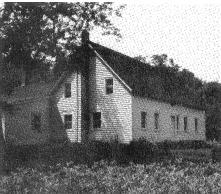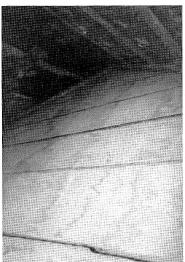|
Dutch
Barn Preservation Society
Dedicated
to the Study and Preservation
of New World Dutch Barns
Newsletter,
FALL 1990, Vol. 3, Issue 2
The
Plank Roof:
met planken
bequaem decken
By Shirley Dunn
Planks were a once-popular roofing material for houses,
barns and sheds on early Hudson Valley homesteads. Use of this
roofing is now nearly forgotten, but, occasionally, surviving plank
roofs can still be found under later roofs or sheltered by additions.
For example, plank roofs have recently been identified on some
Schenectady and Albany County Dutch barns. The Teller Barn of Schenectady
had a plank roof when it was taken down some forty years ago. In
addition, plank roofs remain in place on an early house in Schenectady
and on one in Schodack, NY.
While undoubtedly they may remain on other structures, such roofs
usually go unrecognized because they are covered with later materials
and, most importantly, because the type has been forgotten. Present
day owners may assume that the carefully fitted boards above the
rafters on old houses or barns are merely old roof boards when,
in fact, they once were the roof itself. For the same reason, references
to plank roofs in early housing contracts and other documents have
been overlooked or misunderstood.
Plank roofs once were common enough. In upstate New York, plank
roofs were still applied to structures as late as the mid-eighteenth
century. Peter Kalm, a traveling Swedish naturalist who recorded
information about each area he visited, wrote about houses north
of Albany that the "roof was either of boards or shingles.
.. " (Kalm, Travels in North America, Vol. II, Dover,
1966, 612).
A properly beveled and fitted plank roof sheds water and snow
efficiently and was as satisfactory as any other roof covering.
If, after the passage of years, boards split or shrank, the plank
roof made a solid base for wood shingles. While some plank roofs
undoubtedly were intended as temporary expedients, others were
installed with sufficient craftsmanship to survive as the sole
roof covering for many years. One of the best examples survives
on a mid-eighteenth century house near South Schodack, NY. (See
illustrations.)
The plank roof was in use in the Albany area and in other settlement
areas along the seacoast as long ago as the seventeenth century.
Planks and boards were readily available at an early date, particularly
in New Netherland, and were specified in building contracts in
Beverwyck (Albany) and Manhattan documents by the 1640's. Numerous
early saw mills in the Dutch colony processed abundant timber;
consequently, sawn lumber was widely available during the long
land-clearing phase of European settlement
Occasional wooden roofs appear in Netherlands paintings of the
period, although many roofs in the homeland were thatched or tiled.
All three materials, thatch, tile, and wood, were experimented
with here during the first few years of Dutch settlement in New
Netherland. At first, thatched roofs covered many area structures
as they did on the continent However, the harsher climate and limited
materials (straw was substituted for reeds) in New Netherland did
not encourage the continued use of thatch. In addition, thatched
roofs were recognized as fire hazards, especially in cities.
To substitute for thatch, a householder might choose pantiles,
planks, or shingles. In America, as overseas, pantiles, while often
the preferred roofing, proved, I believe, more expensive than other
coverings. Moreover, loads of tiles were probably difficult to
transport due to weight and fragility. Consequently, tiles emerged
as a prestigious roofing limited, in the main, to public buildings
and city residences of substance. White pine or cedar shingles
were known to the Dutch and their English successors, but, as a
product of intensive hand labor, they also were expensive. It is
my opinion that shingles were not used very widely here in the
seventeenth century because mention of shingles is rare in early
Hudson Valley building contracts.
Therefore, for utility buildings such as barns, and for housing
stock when pantiles could not be obtained, planks were a popular
and culturally acceptable roofing material, one already familiar
to the Dutch community. In addition, from earliest settlement through
the eighteenth century, the abundant sawn materials were reasonably
cheap.
 <-Although
now covered, the plank roof on this Dutch-style house near South
Schodack, NY remains visible in the attic of the addition shown
at left. Photo, spring, 1988, by Shirley Dunn. <-Although
now covered, the plank roof on this Dutch-style house near South
Schodack, NY remains visible in the attic of the addition shown
at left. Photo, spring, 1988, by Shirley Dunn.
A plank roof had one more attribute besides availability, cultural
acceptance and economy. Planks on a roof made a building relatively
fire-safe. This attribute of plank roofs was part of the public's
consciousness for many years.
In February, 1656, an impoverished old man, Willem Juriensz,
was unable to remove his dangerous thatched roof in the village
of Beverwyck. His neighbors were called on to make a contribution
to replace Juriensz' condemned
"straw" roof, with one of planks, "in order, thereby,
as far as possible, to prevent all danger of fire." A variety
of individuals contributed for the new roof according to their
concern and ability - Sander Leendertze, 12 planks and eight guilders'
worth of nails; Rutger Jacobs, 5 planks; Andries Herpertz, 8 planks
- and so on, making clear the character of the new and safer plank
roof (Minutes of the Court of Fort Orange and Beverwyck,
Vol. I, p. 238, 255). [Note: the Dutch word "planken" was
verified courtesy of Charles Gehring, translator for the New Netherland
Project]
The feeling that planks were a relatively safe roof may have
contributed to their continued use for houses and barns long into
the eighteenth century, even when pine shingles were readily available.
For example, in the 1740's, when an outbreak of the French and
Indian wars threatened, an Albany blockhouse, an important link
in the stockade around the city, was ordered to be covered with
boards, probably as a protection against flaming brands. The City
Records record the following:
October 26, 1743. This board agreed with Anthony Bratt to remove
the block house near the City Hall to the place where the powder
house stands upon the plain, and to putt it up there, to find
all the materials necessary, to mason the stone of the foundation
above ground with lime, to put a new roof of squared pine boards
thereon, to mason the pipe of the chimney above the house with
lime, and to make draws before the portholes below, and to finish
all compleat ... (Munsell, Annals of Albany, Vol. X,
Albany, 1859, 114.)
Plank roofs were not unique to the Albany area. Seventeenth:century
records from Manhattan mention plank and, occasionally, clapboard
roofs. In 1642, a house built by Thomas Chambers was to be enclosed
all around and covered overhead with clappoards "tight against
the rain." (New York. Historical Manuscripts: Dutch,
Vol. II, 13-14). Near Manhattan in 1649, Symon Root and Renier
Somenson agreed to build two identical houses on which the roof
frame was to be covered with planks (New York Historical Manuscripts:
Dutch, Vol. III, 103). Further up the river, in June 1676,
Claes Jansen agreed to build a house for Dirck Benson at Claverack
(present Columbia County, NY), for which the contractor was to
met plancken bequaem decken, "suitably cover the
roof of the house with planks" (Early Records of Albany,
Notarial Papers 1660-1696, 346). Earlier in 1676, the same
Claes Jansen had contracted to erect a house, probably at Albany,
with a roof of "overlapping planks" for Hans Hendricksen.
This reference is important because it gives a clue to the method
of application of the planks (Early Records of Albany 1660-1696,
471). [Again, Charles Gehring, of the New Netherland Project, has
verified that the Dutch word "planken"
appears in the originals.]
Plank or clapboard roofs were not limited to the Dutch of New
Netherland and could take more than one form. For example, the
mid-seventeenth century Adam Thoroughgood House in Virginia Beach,
Virginia, retains sections of an early clapboard roof under later
roofing. The early roof consisted of horizontal overlapping oak
clapboards about 56 inches long and six inches deep. Both ends
of each clapboard were feathered and they were nailed with two
nails at the overlap of the feathered ends, while one nail secured
the clapboard at midpoint. All nailing occurred on roof rafters.
The extant Brush-Everard House at Williamsburg, Virginia, retains
similar roofing from the eighteenth century, featuring somewhat
longer boards.
 <-Part
of the original plank roof, preserved when an addition was put
on the house shown on page three. No shingles were ever nailed
over these fitted boards. <-Part
of the original plank roof, preserved when an addition was put
on the house shown on page three. No shingles were ever nailed
over these fitted boards.
However, surviving Dutch plank roofs are different from the clapboard
roofs of Virginia. Existing roofs in Schenectady and Schodack contain
wide milled planks laid horizontally in uniform lengths up to ten
or eleven feet. These planks met and were nailed at a seam over
a central roof rafter. The seam and the plank ends probably were
covered by a narrow strip of wood. The lengthwise edges of the
planks were beveled to provide a water-resistant lap over the plank
below. There were no gaps in the original tightly fitted installation.
A common phrase in New Netherland building contracts is
"roof and floor tight," referring to the fitting together
of boards or planks. In contrast, common roof sheathing intended
to support wood shingles consisted of irregular boards which provided
gaps and openings.
Although the custom of roofing houses and barns, including some
Dutch barns, with horizontal fitted planks continued well into
the
eighteenth century, the practice in the upper Hudson area seems
to end after the coming of many New Englanders to the Albany area
in the decades after the end of the French and Indian wars. While
there was less timber in established settlement areas by then,
probably the main reason the roofs went out of fashion before 1800
was a social one - their association with the perceived "old-fashioned" and "inconvenient"
Dutch way of life.
Casual use of boards on roofs of outbuildings probably knows
no time limits. However, carefully crafted plank roofs with a beveled
overlap can be an indicator that a structure predates the end of
the eighteenth century and probably predates the Revolution. The
wooden roof was a familiar sight in the seventeenth and eighteenth
centuries. Its utilitarian practicality featuring a material widely
available, fire resistant, and relatively inexpensive, as well
as its cultural acceptability, led to its use on a variety of buildings
in the country and also in the city.
Such roofs when discovered on a Dutch barn or old house should
be preserved as part of the craftsmanship and uniqueness of the
building's architecture. These unusual roofs serve, as well, as
important historical evidence of the, origins and evolution of
the conservative social environment which characterized areas of
North European settlement, the very areas where Dutch barns are
found.
The author, a Trustee and former president
of the Dutch Barn Preservation Society, is Editor of the Newsletter.
The
Dutch Barn Preservation Society
c/o
The Mabee Farm Historic Site
1080 Main St. (Rt. 5S)
Rotterdam
Junction, NY 12150
Site
Phone: (518) 887-5073
DBPS
SITE MAP

Copyright
© 2007. Dutch Barn Preservation Society. All rights reserved.
All items on the site are copyrighted. While we welcome you to
use the information provided on this web site by copying it, or
downloading it; this information is copyrighted and not to be reproduced
for distribution, sale, or profit. |